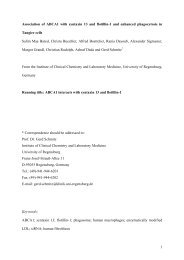SUNDAY, DECEMBER 4- Late Abstracts 1 - Molecular Biology of the ...
SUNDAY, DECEMBER 4- Late Abstracts 1 - Molecular Biology of the ...
SUNDAY, DECEMBER 4- Late Abstracts 1 - Molecular Biology of the ...
Create successful ePaper yourself
Turn your PDF publications into a flip-book with our unique Google optimized e-Paper software.
<strong>SUNDAY</strong><br />
calcium release and actin polymerization. Taken toge<strong>the</strong>r, <strong>the</strong> data implicate FPR1 in mediating<br />
lens cell migration, a critical event for lens development and maintenance.<br />
2055<br />
PRL-3 promotes migration and invasion by up-regulating MMP-7 in human colorectal<br />
cancer cells.<br />
Y-M. Han 1 , S-K. Lee 2 , D-S. Sin 2 , Y-R. Ha 2 , J. Kim 2 , C-W. Lee 3 ; 1 University <strong>of</strong> Science and<br />
Technology, Daejeon, Korea, 2 Laboratory <strong>of</strong> Chemical <strong>Biology</strong> and Genomics, Korea Research<br />
Institute <strong>of</strong> Bioscience and Biotechnology, Daejeon, Korea, 3 Bio-Evaluation Center, Korea<br />
Research Institute <strong>of</strong> Bioscience and Biotechnology, Chungbuk, Korea<br />
PRL-3, a member <strong>of</strong> a subgroup <strong>of</strong> protein tyrosine phosphatases (PTPs) that can stimulate <strong>the</strong><br />
degradation <strong>of</strong> <strong>the</strong> extracellular matrix, is over-expressed in metastatic colorectal cancer relative<br />
to primary tumors. To determine whe<strong>the</strong>r PRL-3-induced enhancement <strong>of</strong> migration and<br />
invasion is dependent on <strong>the</strong> expression <strong>of</strong> matrix metalloproteases (MMPs), PRL-3 was<br />
expressed in DLD-1 human colorectal cancer cells. The motility, migration and invasion<br />
characteristics <strong>of</strong> <strong>the</strong> cells were examined and metastasis to <strong>the</strong> lung was confirmed in a nude<br />
mouse using PRL-3-overexpressing DLD-1 cells [DLD-1 (PRL-3)]. Migration and invasion <strong>of</strong> <strong>the</strong><br />
cells were inhibited by phosphatase and farnesyl transferase inhibitors. Expression <strong>of</strong> MMPs<br />
was enhanced 3- to 10-fold in comparison to control cells, and migration and invasion were<br />
partially inhibited by siRNA knockdown <strong>of</strong> MMP-2, -13, or -14. Importantly, siRNA knockdown <strong>of</strong><br />
MMP-7 completely inhibited <strong>the</strong> migration and invasion <strong>of</strong> DLD-1 (PRL-3) cells, while<br />
overexpression <strong>of</strong> MMP-7 increased migration. The expression <strong>of</strong> MMP-7 was also downregulated<br />
by phosphatase and farnesyl transferase inhibitors. It was found that PRL-3 induced<br />
MMP-7 through oncogenic pathways including PI3K/AKT and ERK, and that <strong>the</strong>re is a<br />
relationship between <strong>the</strong> expression <strong>of</strong> PRL-3 and MMP-7 in human tumor cell lines. The<br />
expression <strong>of</strong> MMP-13 and MMP-14 was very sensitive to <strong>the</strong> inhibition <strong>of</strong> farnesyl transferase;<br />
however, <strong>the</strong> migration and invasion <strong>of</strong> DLD-1 (PRL-3) cells did not strongly depend on <strong>the</strong><br />
expression <strong>of</strong> MMP-13 or -14. These results suggest that <strong>the</strong> migration and invasion <strong>of</strong> PRL-3expressing<br />
colorectal cancer cells depends primarily on <strong>the</strong> expression <strong>of</strong> MMP-7.<br />
2056<br />
Serine phosphorylation in paxillin is important for focal adhesion formation during cell<br />
adhesion onto collagen type I.<br />
T. Kwak 1 , J. W. Lee 1 ; 1 Department <strong>of</strong> Pharmacy, Research Institute <strong>of</strong> Pharmaceutical<br />
Sciences, College <strong>of</strong> Pharmacy, Seoul National University, Seoul, Korea<br />
Integrin-mediated adhesion to extracellular matrix proteins is dynamically regulated during<br />
morphological change and cell migration. Upon cell adhesion, protein-protein interaction at focal<br />
adhesions consisting <strong>of</strong> FAK, talin, paxillin, and o<strong>the</strong>rs, plays major roles in regulation <strong>of</strong> cell<br />
morphogenesis and migration. Although phosphorylation at tyrosines <strong>of</strong> paxillin has been well<br />
known to be critically involved in adhesion-mediated signaling, little is known about <strong>the</strong><br />
significance <strong>of</strong> paxillin phosphorylation at serine 85 in cell migration. Here in this study, we<br />
provide evidences that paxillin phosphorylation at serine 85 occurred during HeLa cell adhesion<br />
onto collagen I, being concomitant with FAK and talin phosphorylations. However,<br />
unphosphorylatable mutant S85A paxillin impaired cell spreading, focal adhesion turnover, and<br />
migration toward collagen I but not to serum components. Fur<strong>the</strong>r, <strong>the</strong> physical interaction<br />
between paxillin and talin was through <strong>the</strong> C-terminal tail <strong>of</strong> talin leading to focal adhesions at<br />
<strong>the</strong> cell boundary, but S85A paxillin did not bind talin and caused random focal adhesion<br />
formation. Toge<strong>the</strong>r, <strong>the</strong>se observations suggest that paxillin phosphorylation at Serine 85<br />
depending on cell adhesion is important for interaction with talin and for cell morphological and
















